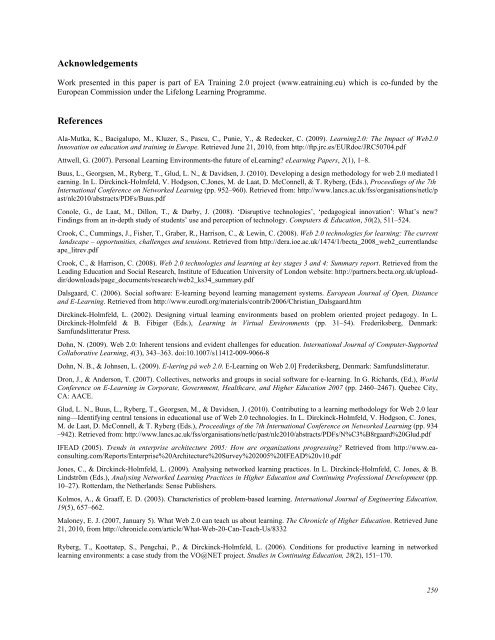October 2012 Volume 15 Number 4 - Educational Technology ...
October 2012 Volume 15 Number 4 - Educational Technology ...
October 2012 Volume 15 Number 4 - Educational Technology ...
Create successful ePaper yourself
Turn your PDF publications into a flip-book with our unique Google optimized e-Paper software.
Acknowledgements<br />
Work presented in this paper is part of EA Training 2.0 project (www.eatraining.eu) which is co-funded by the<br />
European Commission under the Lifelong Learning Programme.<br />
References<br />
Ala-Mutka, K., Bacigalupo, M., Kluzer, S., Pascu, C., Punie, Y., & Redecker, C. (2009). Learning2.0: The Impact of Web2.0<br />
Innovation on education and training in Europe. Retrieved June 21, 2010, from http://ftp.jrc.es/EURdoc/JRC50704.pdf<br />
Attwell, G. (2007). Personal Learning Environments-the future of eLearning? eLearning Papers, 2(1), 1–8.<br />
Buus, L., Georgsen, M., Ryberg, T., Glud, L. N., & Davidsen, J. (2010). Developing a design methodology for web 2.0 mediated l<br />
earning. In L. Dirckinck-Holmfeld, V. Hodgson, C.Jones, M. de Laat, D. McConnell, & T. Ryberg, (Eds.), Proceedings of the 7th<br />
International Conference on Networked Learning (pp. 952–960). Retrieved from: http://www.lancs.ac.uk/fss/organisations/netlc/p<br />
ast/nlc2010/abstracts/PDFs/Buus.pdf<br />
Conole, G., de Laat, M., Dillon, T., & Darby, J. (2008). ‘Disruptive technologies’, ‘pedagogical innovation’: What’s new?<br />
Findings from an in-depth study of students’ use and perception of technology. Computers & Education, 50(2), 511–524.<br />
Crook, C., Cummings, J., Fisher, T., Graber, R., Harrison, C., & Lewin, C. (2008). Web 2.0 technologies for learning: The current<br />
landscape – opportunities, challenges and tensions. Retrieved from http://dera.ioe.ac.uk/1474/1/becta_2008_web2_currentlandsc<br />
ape_litrev.pdf<br />
Crook, C., & Harrison, C. (2008). Web 2.0 technologies and learning at key stages 3 and 4: Summary report. Retrieved from the<br />
Leading Education and Social Research, Institute of Education University of London website: http://partners.becta.org.uk/uploaddir/downloads/page_documents/research/web2_ks34_summary.pdf<br />
Dalsgaard, C. (2006). Social software: E-learning beyond learning management systems. European Journal of Open, Distance<br />
and E-Learning. Retrieved from http://www.eurodl.org/materials/contrib/2006/Christian_Dalsgaard.htm<br />
Dirckinck-Holmfeld, L. (2002). Designing virtual learning environments based on problem oriented project pedagogy. In L.<br />
Dirckinck-Holmfeld & B. Fibiger (Eds.), Learning in Virtual Environments (pp. 31–54). Frederiksberg, Denmark:<br />
Samfundslitteratur Press.<br />
Dohn, N. (2009). Web 2.0: Inherent tensions and evident challenges for education. International Journal of Computer-Supported<br />
Collaborative Learning, 4(3), 343–363. doi:10.1007/s11412-009-9066-8<br />
Dohn, N. B., & Johnsen, L. (2009). E-læring på web 2.0. E-Learning on Web 2.0] Frederiksberg, Denmark: Samfundslitteratur.<br />
Dron, J., & Anderson, T. (2007). Collectives, networks and groups in social software for e-learning. In G. Richards, (Ed.), World<br />
Conference on E-Learning in Corporate, Government, Healthcare, and Higher Education 2007 (pp. 2460–2467). Quebec City,<br />
CA: AACE.<br />
Glud, L. N., Buus, L., Ryberg, T., Georgsen, M., & Davidsen, J. (2010). Contributing to a learning methodology for Web 2.0 lear<br />
ning—Identifying central tensions in educational use of Web 2.0 technologies. In L. Dirckinck-Holmfeld, V. Hodgson, C. Jones,<br />
M. de Laat, D. McConnell, & T. Ryberg (Eds.), Proceedings of the 7th International Conference on Networked Learning (pp. 934<br />
–942). Retrieved from: http://www.lancs.ac.uk/fss/organisations/netlc/past/nlc2010/abstracts/PDFs/N%C3%B8rgaard%20Glud.pdf<br />
IFEAD (2005). Trends in enterprise architecture 2005: How are organizations progressing? Retrieved from http://www.eaconsulting.com/Reports/Enterprise%20Architecture%20Survey%202005%20IFEAD%20v10.pdf<br />
Jones, C., & Dirckinck-Holmfeld, L. (2009). Analysing networked learning practices. In L. Dirckinck-Holmfeld, C. Jones, & B.<br />
Lindström (Eds.), Analysing Networked Learning Practices in Higher Education and Continuing Professional Development (pp.<br />
10–27). Rotterdam, the Netherlands: Sense Publishers.<br />
Kolmos, A., & Graaff, E. D. (2003). Characteristics of problem-based learning. International Journal of Engineering Education,<br />
19(5), 657–662.<br />
Maloney, E. J. (2007, January 5). What Web 2.0 can teach us about learning. The Chronicle of Higher Education. Retrieved June<br />
21, 2010, from http://chronicle.com/article/What-Web-20-Can-Teach-Us/8332<br />
Ryberg, T., Koottatep, S., Pengchai, P., & Dirckinck-Holmfeld, L. (2006). Conditions for productive learning in networked<br />
learning environments: a case study from the VO@NET project. Studies in Continuing Education, 28(2), <strong>15</strong>1–170.<br />
250

















